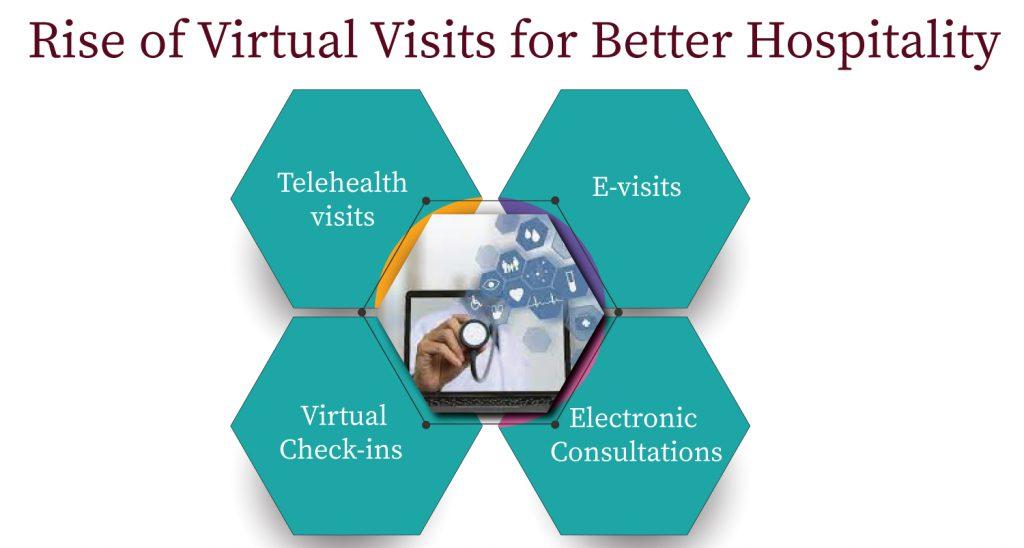The Rise of Telemedicine in Endocrinology: Benefits & Challenges
If you are an endocrinologist in the USA or anywhere else, we are sure your patients too complain of the limited consultation time. But it’s a challenge that is hard to overcome in traditional healthcare. Today, the rise of telemedicine endocrinology is changing things for the better.
A telehealth endocrinologist can offer consultation services to patients in a remote manner. The apparent benefit is of course more time and efficiency. However, telemedicine endocrinology provides a whole set of benefits for providers and patients.
But let’s first try to understand what is a telehealth platform for providers.
A telehealth platform brings doctors. Patients, and related healthcare services together. It is a digital platform that unites the healthcare system safely and securely. If you are using a telemedicine platform in the USA, ensure it is HIPAA compliant. A HIPAA-compliant telemedicine keeps your patient data safe and secure.
Now that we have covered the basics, let’s move over to telemedicine endocrinology!
Table of Contents
- Rise Of Telemedicine in the Healthcare Industry
- Rise of Virtual Visits for Better Hospitality
- Pandemic & Telehealth Solutions
- Telemedicine Solutions & Endocrinology
- Outcomes of Telemedicine in Endocrinology
- Conclusion
Rise Of Telemedicine in the Healthcare Industry
The American Telemedicine Association established an online patient consultation, accreditation program in 2015 to recognize firms that provide online. These real-time patient health services meet operational, clinical, and consumer-related standards. Besides telemedicine endocrinology has paved the way with the rise of telemedicine.
The program emphasizes patient safety, operational openness, and compliance with all applicable laws and regulations. Telehealth, telemedicine, and related concepts are defined by the Centers for Medicare and Medicaid Services (CMS) as “the exchange of medical information from one site to another via electronic communication to enhance a patient’s health.”
As of March 6, 2020, Medicare will pay for office, hospital, and other telehealth visits provided across the country. Including in patients’ homes, under the new 1135 waiver. Patients can get telehealth services from physicians, nurse practitioners, psychologists, and licensed clinical social workers. Before the 1135 waiver, Medicare only paid for telehealth in certain circumstances. The person getting the service had to be from a defined rural area and had to go to a clinic, hospital, or certain other types of medical facilities for remote treatment.
Rise of Virtual Visits for Better Hospitality
CMS classifies virtual visits into telehealth visits, virtual check-ins, and e-visits.

1. Telehealth visits
These are similar to in-person visits in that they involve interactive real-time audio-video communication between a clinician at a remote location and the patient at home.
2. Virtual Check-ins
Virtual check-ins are quick communication services with a practitioner via various communication technologies, such as synchronous telephone talk or information exchange by video or image.
3. E-visits
These non-face-to-face small conversations initiated by patients through online patient portals with their doctor are accommodated with the help of telehealth software.
4. Electronic Consultations (e-consults)
The asynchronous clinician-to-clinician discussions based on record reviews from inpatient and outpatient settings may eliminate the need for face-to-face specialist appointments. E-consultation programs are becoming increasingly popular.
A recent systematic review stated that there might be publication bias in those favorable outcomes of e-consults are more likely to be published and that more rigorous research on e-consults is needed.
Pandemic & Telehealth Solutions
Following the December 2019 epidemic of coronavirus disease 2019 (COVID-19), also known as the novel coronavirus, or 2019-nCoV, in Wuhan, China, the disease has spread fast across numerous nations. On January 20, 2020, the first case was confirmed in the United States. On March 11, 2020, the World Health Organization proclaimed COVID-19 a pandemic.
Following the presidential designation of COVID-19 as a national emergency in the United States on March 13, 2020, multiple states issued stay-at-home orders on various dates. Following that, the CMS expanded access to Medicare Telehealth services to allow its beneficiaries to receive a full range of services from their physicians without visiting a health care facility, lowering their chance of contracting the virus and putting others at risk.
Acceptance of Telehealth Solution as the Saviour
Under the 1135 waiver, Medicare agreed to pay healthcare facilities for care delivered to its beneficiaries via telehealth across the country on a temporary and emergency basis to prevent the virus’s community spread.
Furthermore, as of March 27, 2020, the CMS had granted the 1135 waiver for Medicaid beneficiaries in 34 States. The CMS finalized policies on April 5, 2020, improving plan options and benefits, including allowing Medicare Advantage plans to offer more telehealth features.
CMS issued a second round of adjustments to boost telehealth on April 30, 2020, and agreed to increase compensation for phone visits. In reaction to COVID-19, many states have provided emergency waivers to providers with out-of-state credentials. Furthermore, the Federation of States Medical Boards (FSMB) provides timely assistance in providing critical information required to verify licenses and credentials for physicians and other healthcare professionals wishing to practice across state lines to treat patients in areas heavily impacted by COVID-19.
Policy solutions to increasing telehealth are an appropriate start in addressing this epidemic with severe socio-economic consequences in the United States and elsewhere. According to the New York Times database, as of May 27, 2020, more than 1.7 million people in the United States had tested positive for the virus, and more than 100,000 had died. However, as the use of telehealth grows, information about adoption rates in various practice settings and geographic locales will be invaluable.
Telemedicine Solutions & Endocrinology
The blog aims to describe the rates of telemedicine use among endocrinologists and investigate practitioner characteristics.
Survey Design and Administration
A web-based survey was created using Google Forms. The survey was sent to endocrinologists in the Facebook group “Endocrinologists”. When the poll was conducted, this private group had 2,233 endocrinologists as members, with more than 95% of the members working in the United States (confirmed by the Group Administrator).
The questionnaire comprised 11 single-selection, multiple-choice questions and a section for comments and ideas. The MidMichigan Health Institutional Approval Board determined that this poll did not require review. All eleven questions were required. The Comments and Suggestions section was optional.
The survey link was made available on April 2, 2020, with reminders given on April 3 and 7, 2020. The survey ended on April 7, 2020. Responses were acquired anonymously, and neither the authors nor Facebook offered any inducement for survey completion. Google Forms was used to gather and electronically store survey responses, which were password-protected.
There were 214 answers in all. Multiple responses from a single responder were discovered during a data quality check. After deleting duplicates, the total number of answers was 181. The complete survey can be found online.
Statistical Analyses
SPSS v.25 was used for statistical analysis (IBM Corporation, Chicago, IL). There were no respondent IDs in the raw data, which was consistent with the exempt status claimed by the Institutional Review Board. For each question, frequencies and percentages for each level of response were determined for descriptive purposes.
For inferential analyses, age brackets were recorded to two levels: younger than or equal to 40 years and older than 40. This age adjustment was designed to investigate if younger endocrinologists are more likely to adopt a new change, such as telemedicine for doctors.
Regarding gender, the one respondent who did not identify as male or female was omitted from the inferential analyses. One explanation was that inferential modeling would not have worked for this reaction at such a low frequency. The other reason was that there was no ethical bearing regarding minority and vulnerable population representation in our study setting.
Based on the distribution of states by the United States Census Bureau. The respondents’ state was recorded into four geographic regions: Midwest, Northeast, South, and West. The practice was categorized as rural or urban, as well as private v/s employed.
Owners and private practice partners were included in the private practice group. Whereas employment by a hospital/group or an academic institution was included in the employed group. Other characteristics elicited in the survey included:
- Prior telehealth experience before the COVID-19 outbreak.
- Telehealth experience in residency or fellowship.
- Patient population (adults, pediatrics, or combined).
- Type of practice (employed versus private practice).
- Overall satisfaction with telehealth on a scale of 1 to 10.
Outcomes of Telemedicine in Endocrinology
Following are the benefits of having telemedicine deployed in telemedicine Endocrinology. Let’s check them out!
Data on Survey Respondents
The survey received 181 responses, representing a response rate of 8%. The majority of respondents (75% were female), more than half were under 40 (51%), and all major geographic regions of the United States were represented.
Data on Telehealth
8% of the 181 respondents had telehealth experience during their residency and fellowship programs. Before the COVID-19 epidemic, 89% of the responders had no telehealth experience during or after residency and fellowship training.
In the COVID-19 circumstance, more than two-fifths (44%) shifted to virtual visits in the outpatient context, an additional 44% switched to the majority of virtual visits with some in-person visits, and 11% did a majority of in-person visits and some virtual visits. Only 0.55% of patients continued with only in-person sessions in an outpatient setting.
Data on Overall Physician Satisfaction with Telehealth
Most answering endocrinologists (86.5%) gave an overall satisfaction rating of 6 or above out of 10.
Inferential Analyses on the Association of Respondent Characteristics and Adoption of Telehealth
Inferential studies revealed statistically significant relationships between telehealth adopters and two features of respondent endocrinologists: age and geographic location.
1. In the outpatient context, the odds of adopting telehealth were 3.08 times greater if the physician was under 40 versus more than 40 years old. Furthermore, the adoption of telemedicine was significantly lower among endocrinologists in the southern states. Other than the South, the odds of adopting telehealth were 3.21 times greater.
2. Telehealth adoption in the inpatient setting proved low in both the South and the West. Because there were just four respondents from the West, interpretation was difficult.
Transform your endocrinology care! Try VCDoctor White-label and HIPAA Compliant Telemedicine.
Conclusion
To wrap up, the rise of telemedicine platform for patients, especially post-Covid-19, has been significant. And, this is backed by various research as well, the links to some of which we have shared in the blog too.
Today, telehealth is being used in diverse healthcare specialties, including telemedicine endocrinology. Telehealth platforms help providers save valuable time, pay better attention to their patients, and even help their chronic patients. With endocrinology telehealth, you can educate patients better and even help them manage their hormonal conditions more effectively.
VCDoctor helps providers like you offer online endocrinologist consultation services in a hassle-free way. Our platform is fully white-label, customizable, and comes with advanced features on demand.
With VCDoctor you can set up an telemedicine endocrinologist services in no time. So if you want a telehealth platform that is HIPAA compliant and helps you take your care services to maximum patients- try VCDoctor telemedicine platform for providers.
FAQs
Q: Why does HIPAA compliance matter in a telehealth platform for providers?
HIPAA compliance matters because virtual appointments share patient health information electronically. This patient information (health records, medical insurance, diagnosis, tests, etc) has to be well-protected.
HIPAA sets the rights standards and guidelines to store, share, and manage digital patient records. That’s why HIPAA compliance is a must for a telehealth platform for providers.
Q: Is VCDoctor HIPAA compliant, and is there any other compliance that VCDoctor meets?
Yes, VCDoctor is HIPAA HIPAA-compliant telehealth platform for providers. Other than HIPAA compliance, we also offer GDPR, NABIDH, and ABDM-compliant telehealth solutions. But these features are only available on demand.
Q: How much time does it take to set up VCDoctor?
The average time is 1-2 weeks. So 10-14 days is all it takes to start your online endocrinologist consultation.
Q: Can I get a VCDoctor demo?
Yes, you can book a VCDoctor demo. Simply visit our contact page, add your details, pick a date and time slot, and we will plan the demo for you.
Q: Can I rebrand VCDoctor?
Yes, VCDoctor is a white-label telemedicine platform. You can rebrand it as your virtual endocrinologist clinic.




